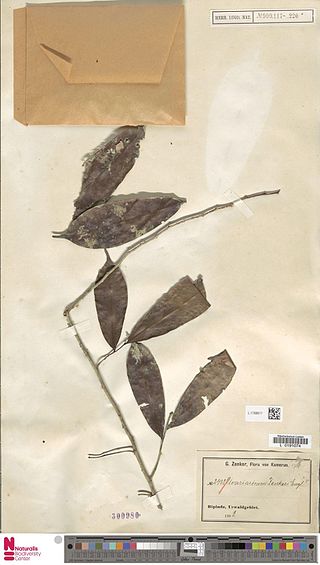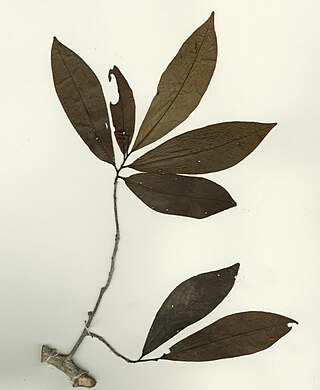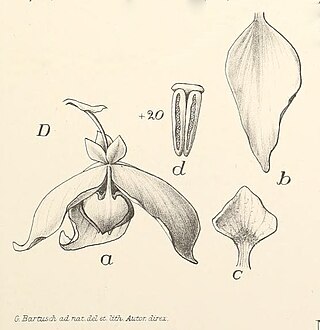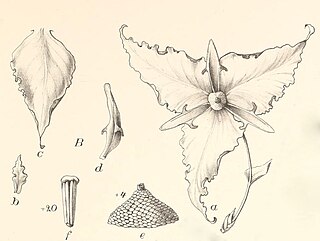
The Annonaceae are a family of flowering plants consisting of trees, shrubs, or rarely lianas commonly known as the custard apple family or soursop family. With 108 accepted genera and about 2400 known species, it is the largest family in the Magnoliales. Several genera produce edible fruit, most notably Annona, Anonidium, Asimina, Rollinia, and Uvaria. Its type genus is Annona. The family is concentrated in the tropics, with few species found in temperate regions. About 900 species are Neotropical, 450 are Afrotropical, and the remaining are Indomalayan.

Monodora myristica, the calabash nutmeg, is a tropical tree of the family Annonaceae or custard apple family of flowering plants. It is native to Angola, Benin, Cameroon, the Central African Republic, the Democratic Republic of the Congo, Equatorial Guinea, Gabon, Ghana, Guinea-Bissau, Ivory Coast, Kenya, Liberia, Nigeria, the Republic of the Congo, Sierra Leone, Sudan, Tanzania, Togo and Uganda. In former times, its seeds were widely sold as an inexpensive nutmeg substitute. This is now less common outside its region of production. Other names of calabash nutmeg include Jamaican nutmeg, African nutmeg, ehuru, ariwo, awerewa, ehiri, airama, African orchid nutmeg, muscadier de Calabash and lubushi.
Isolona congolana is a species of plant in the Annonaceae family. It is found in the Democratic Republic of the Congo and Uganda. It has also recently been found in southern Africa.
Isolona is a genus of flowering plants in the family Annonaceae. There are 21 species native to Africa. They occur in humid habitat types.

Polyceratocarpus is a genus of flowering plants in the family Annonaceae. All known species are native to continental Africa.

Uvariastrum is a genus of plants in the Annonaceae native to sub-Saharan Africa.
Uvariopsis is a genus of flowering plants in the family Annonaceae. The genus is unique to Africa, and consists of about 18 species, all of which are either ramiflorous, cauliflorous or both.
Asteranthe asterias is a species of plant in the family Annonaceae. It is native to Kenya and Tanzania. Spencer Le Marchant Moore, the English botanist who first formally described the species using the basionym Uvaria asterias, did not explicitly explain the epithet, but was likely referencing the star-like appearance of its flower’s petals.
Hexalobus bussei is a species of plant in the family Annonaceae. It is native to Cameroon. Ludwig Diels, the German botanist who first formally described the species, named it after another German botanist, Walter Busse, who collected the sample that Diels examined.
Monodora crispata is a species of plant in the family Annonaceae. It is native to Cameroon, Equatorial Guinea, Gabon, Ghana, Guinea, Ivory Coast, Liberia, Nigeria, and Sierra Leone. Heinrich Gustav Adolf Engler, the German botanist who first formally described the species, named it after its curled petal margins.

Monodora hastipetala is a species of plant in the family Annonaceae. It is native to Tanzania. Thomas Couvreur, the botanist who first formally described the species, named it after its spear shaped inner petals.

Monodora junodii is a species of plant in the family Annonaceae. It is native to Eswatini, Kenya, Malawi, Mozambique, South Africa, Tanzania, and Zimbabwe. Heinrich Gustav Adolf Engler and Ludwig Diels, the German botanists who first formally described the species, named it after Henri-Alexandre Junod, the Swiss missionary and scientist who collected the specimen that they examined.

Monodora minor is a species of plant in the family Annonaceae. It is native to Mozambique and Tanzania. Heinrich Gustav Adolf Engler and Ludwig Diels, the German botanists who first formally described the species, do not explicitly explain the specific epithet but it is among the smaller members of the genus which includes species that reach heights of 30-40 meters.

Monodora stenopetala is a species of plant in the family Annonaceae. It is native to Malawi and Mozambique. Daniel Oliver, the English botanist who first formally described the species, named it after its narrow petals.

Annonoideae is a subfamily of plants in the family Annonaceae, with genera distributed in tropical areas world-wide. The family and this subfamily are based on the type genus Annona.

Uvariastrum insculptum is a species of plant in the Annonaceae. It is native to Cameroon, Gabon, Ghana, Ivory Coast, Liberia, Nigeria, and the Republic of the Congo. Adolf Engler and Ludwig Diels, the botanists who first formally described the species using the basionym Uvaria insculpta, named it after the secondary veins on its leaves which are distinctly sunken.

Uvariastrum pierreanum is a species of plant in the Annonaceae family. It is native to Cameroon, the Central African Republic, the Democratic Republic of the Congo, Equatorial Guinea, Gabon, Ghana, Guinea, the Ivory Coast, Liberia, Nigeria, Sierra Leone and the Republic of the Congo. Adolf Engler, the botanist who first formally described the species, named it after the French botanist Jean Baptiste Louis Pierre.











